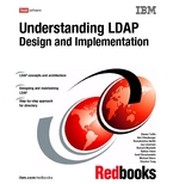 Part 4 Developing directory-enabled applications
by Chunhui Yang, Michael Storrs, Sunil Ranahandola, Nathan Owen, Richard Macbeth, J
Understanding LDAP - Design and Implementation
Part 4 Developing directory-enabled applications
by Chunhui Yang, Michael Storrs, Sunil Ranahandola, Nathan Owen, Richard Macbeth, J
Understanding LDAP - Design and Implementation
- Front cover
- Notices
- Preface
- Summary of changes
- Part 1 Directories and LDAP
- Chapter 1. Introduction to LDAP
- Chapter 2. LDAP concepts and architecture
- Chapter 3. Planning your directory
- Part 2 IBM Tivoli Directory Server overview and installation
- Chapter 4. IBM Tivoli Directory Server overview
- Chapter 5. ITDS installation and basic configuration - Windows
- Chapter 6. ITDS installation and basic configuration - AIX
- Chapter 7. ITDS installation and basic configuration on Intel Linux
- Chapter 8. IBM Tivoli Directory Server installation - IBM zSeries
- Part 3 In-depth configuration and tuning
- Chapter 9. IBM Tivoli Directory Server Distributed Administration
- 9.1 Web Administration Tool graphical user interface
- 9.2 Starting the Web Administration Tool
- 9.3 Logging on to the console as the console administrator
- 9.4 Logging on to the console as the server administrator
- 9.5 Logging on as member of administrative group or as LDAP user
- 9.6 Logging off the console
- 9.7 Starting and stopping the server
- 9.8 Console layout
- 9.9 Configuration only mode
- 9.10 Setting up the console
- 9.11 ibmslapd command parameters
- 9.12 Directory administration daemon
- 9.13 The ibmdirctl command
- 9.14 Manual installation of IBM WAS - Express
- 9.15 Installing in WebSphere Version 5.0 or later
- Chapter 10. Client tools
- Chapter 11. Schema management
- Chapter 12. Group and role management
- Chapter 13. Replication
- Chapter 14. Access control
- Chapter 15. Securing the directory
- Chapter 16. Performance Tuning
- 16.1 ITDS application components
- 16.2 ITDS LDAP caches
- 16.2.1 LDAP caches
- 16.2.2 LDAP filter cache
- 16.2.3 Filter cache bypass limits
- 16.2.4 LDAP entry cache
- 16.2.5 Measuring filter and entry cache sizes
- 16.2.6 LDAP ACL Cache
- 16.2.7 Setting other LDAP cache configuration variables
- 16.2.8 LDAP Attribute Cache (only on 5.2 and later)
- 16.2.9 Configuring attribute caching
- 16.3 Transaction and Event Notification
- 16.4 Additional slapd and ibmslapd settings
- 16.5 DB2 tuning
- 16.5.1 Warning when IBM Directory Server is running
- 16.5.2 DB2 buffer pool tuning
- 16.5.3 LDAPBP buffer pool size
- 16.5.4 IBMDEFAULTBP buffer pool size
- 16.5.5 Setting buffer pool sizes
- 16.5.6 Warnings about buffer pool memory usage
- 16.5.7 Other DB2 configuration parameters
- 16.5.8 Warning about MINCOMMIT
- 16.5.9 More DB2 configuration settings
- 16.5.10 Configuration script
- 16.6 Directory size
- 16.7 Optimization and organization
- 16.8 DB2 backup and restore
- 16.9 Concurrent updates on Symmetric Multi-Processor systems
- 16.10 AIX operating system tuning
- 16.11 Adding memory after installation on Solaris systems
- 16.12 SLAPD_OCHANDLERS variable on Windows
- 16.13 IBM Directory Change and Audit Log
- 16.14 Hardware tuning
- 16.15 Monitoring performance
- 16.16 Troubleshooting error files
- Chapter 17. Monitoring IBM Tivoli Directory Server
- Part 4 Developing directory-enabled applications
- Chapter 18. Debugging IBM Tivoli Directory Server related issues
- Chapter 19. Developing C-based applications
- Chapter 20. Developing JNDI-based applications
- Part 5 Appendixes
- Appendix A. DSML Version 2
- Appendix B. Directory Integration - IBM Tivoli Directory Integrator
- Why Directory Integration is important
- Directory Integration Services
- User provisioning applications
- Directory Integration technologies
- Virtual directories vs. metadirectory technology
- Overview of IBM Tivoli Directory Integrator
- Configuration of ITDI assembly lines
- Configuration of an ITDI Event Handler
- ITDI solution example
- ITDI solution design
- Solution components
- Summary
- Appendix C. Moving RACF users to TBDM
- Appendix D. Schema changes that are not allowed
- Related publications
- Back cover


Developing directory-enabled applications
As seen throughout this book, many applications are already LDAP-enabled. They utilize LDAP directories for various purposes, user information, authentication/authorization, configuration settings, and so forth. User applications can benefit from the advantages of directories as well. This chapter gives ideas on how to leverage LDAP directories in self-written applications and introduces the various programming interfaces and methods to directory-enable applications.
For example, a company sets up an enterprise LDAP directory for e-mail clients to use to retrieve e-mail addresses. The information in the directory can be used for various other purposes. The payroll application, for example, could use the directory to retrieve employee addresses. Employees may also want to update their own information in the directory. All of these uses require some sort of programming unless the company has bought software that does exactly what is needed. Virtually all applications whether they are written in C++, Java, Visual Basic, etc., can be LDAP-enabled due to the variety of different application interfaces available.
IBM Directory Server provides a set of Application Programming Interfaces (APIs) that allow users to search a directory or perform operations, such as additions, modifications, or deletions of directory entries. This part of the book contains some examples of how to use APIs in a C or Java application to search for a specific directory entry or to add a new entry into a directory.
-
No Comment
..................Content has been hidden....................
You can't read the all page of ebook, please click here login for view all page.